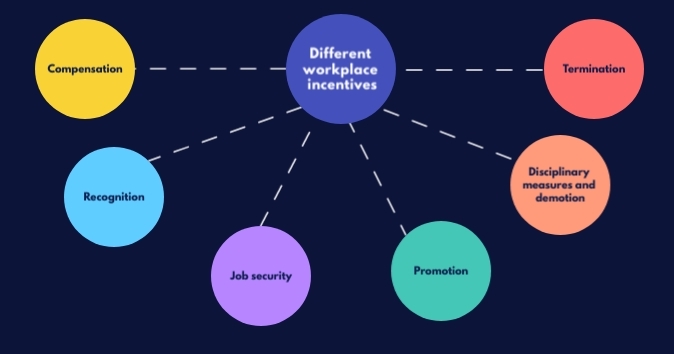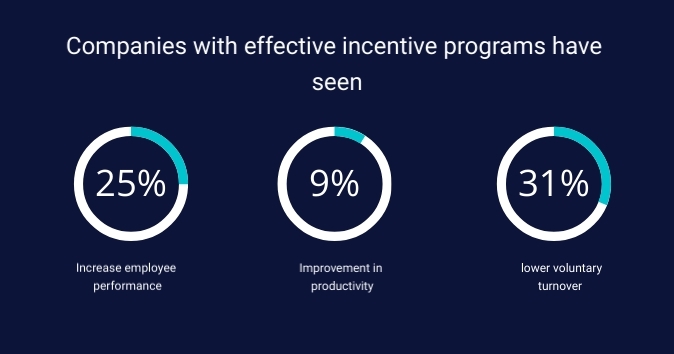What is the Incentive Theory of Motivation?
The incentive theory of motivation is based on the idea that human behavior can be influenced by external factors or incentives which can be both positive and negative. These external incentives motivate people based on the promise of positive rewards or negative consequences.
The incentive theory of motivation exists in all facets of life. It starts as early as childhood when you learn to watch where you step to avoid falling or to say "please" when asking for something you want.
At work, your productivity is influenced by both intrinsic and extrinsic motivations. You might be naturally motivated by praise – intrinsic – and are interested in a promotion – extrinsic. Both of these factors drive you to execute your work in such a way that you can receive both.
Positive incentives are meant to motivate employees with positive outcomes, like promotions, recognition programs, rewards, and the like. They promise that employees will receive something they desire in exchange for doing good work.
Negative incentives are meant to discourage certain behaviors or correct mistakes. They include criticism and admonishments, demotions, pay decreases, and other penalties.
If you're wondering how this motivational theory might apply in the workplace, you're in the right place. Let's discuss the theory, how it can be applied at work, and different examples of both positive and negative incentives.
Different workplace incentives
Different employers offer different workplace incentives to appeal to the variety of their employee's interests. Not everyone is motivated solely by money, nor is money always the most practical reward. Here are a few different types of incentives organizations can offer:

Compensation
Compensation is perhaps the most obvious form of incentive. Compensation can be structured in a number of ways and should be implemented however makes the most sense for your business's needs and long-term goals. Direct compensation methods include:
- Salary pay
- Hourly pay
- Commission pay
- Bonus pay
See also: What is incentive pay?
Indirect compensation methods include equity packages, stock options, employee benefits, and non-monetary incentives.
Compensation plays a role in both attracting and retaining talent. Salary or wages may initially attract someone to your company, but the broader benefits might be what keep them around. Performance-based bonuses and salary increases are also very motivating and can have a real impact on productivity.
Recognition
Receiving recognition for your efforts and accomplishments is a powerful method of positive reinforcement. It signals to an employee that their efforts are being seen, motivating them to engage in this behavior again and again. These moments energize employees and convey appreciation in a meaningful way.
Praise, public acknowledgment, and awards can foster a workplace culture that values a strong work ethic and encourages the pursuit of common goals. Employee recognition can improve employee retention, boost engagement, strengthen company values, and facilitate collaboration.
Job security
Job security is a non-monetary incentive that motivates employees to continue putting forth their best effort to keep their jobs. This can be made more concrete with structures like tenure or probationary periods. These milestones can motivate and engage employees to contribute meaningfully to the organization.
The power of job security can be augmented by tools like performance reviews, where employees can receive positive reinforcement and/or constructive feedback.
Promotion
Many employees are highly motivated by the opportunity for promotion. Promotions are both symbolic and material, providing career advancement and new titles along with an increased sense of job security and a higher salary. They can also contribute to job satisfaction and encourage team members to engage in desired behaviors.
Disciplinary measures and demotion
Negative incentives include disciplinary measures and demotions. These tools serve as a corrective tool to address misconduct or non-compliance. Having a fair, clear, and consistently enforced system of rules and disciplinary measures encourages desired behaviors and discourages (and punishes) poor behavior.
If disciplinary measures don't have the desired effect, the potential for demotion or a different role assignment might. Employees may change their behavior more drastically when this is a possibility and act more motivated to serve the company's best interests.
Termination
Of course, if disciplinary measures and demotions don't have the desirable outcomes, termination is often the next and final step. Informing an employee that this is a real possibility is likely to have a noticeable impact on their behavior, motivating them to improve their productivity to avoid termination.
How to apply incentive theory in the workplace
How can you use incentive theory so that employees are motivated to perform? First, identify what behavior you want to encourage. Collaboration, participation, engagement, and appreciation are all common desired traits.
Next, identify what motivates your employees. Are they interested in non-monetary rewards? Recognition? Financial rewards? Your incentive program will only work if it's relevant to your team. If you're offering incentives that don't interest them, they won't be interested in the program.
If you're not sure what incentives interest your employees, you can (and should) ask them. Rather than simply asking what rewards they want – which they may not know how to answer – you can run them through an exercise that will help identify their core values and motivators. Ask:
- What's your favorite part about your role?
- What aspects of your job make you the happiest? Most fulfilled?
- What do you look forward to each day at work?
- What compels you to do good work?
- What are your goals with this job?
These answers will help you identify what your employees are interested in (as well as what they are motivated to avoid). You should then use this to craft your incentive program.

Examples of incentive theory in the workplace
Your employees can be motivated to perform a task or achieve a goal through various incentives and negative consequences alike. These include:
Bonuses: Financial incentives often celebrate certain milestones and can be a powerful motivator.
Commission: Commission-based pay encourages employees to produce a certain output so that they can earn more.
Recognition: Praise for a job well done can go a long way. Recognition programs make employees feel seen and appreciated, reinforcing that their work is valuable to the organization.
Download Our Exclusive Report
In today’s rapidly changing work environment, it’s more important than ever to cultivate a strong company culture. A recent report published by Gallup in partnership with Workhuman® reveals that only 1️⃣ in 4️⃣ employees feel connected to their company culture.
Don’t let the remote work revolution disconnect your team!
🌐🚀 Discover the power of recognition in building a thriving, connected workplace
Safety: Encourage safety and compliance with a safety incentive program.
Probation: Probation can be used both for new employees to ensure comprehensive onboarding and compliance, as well as for disciplinary measures, enabling these periods to work as both rewards and punishments. It is a reward when the probation period for a new employee passes, and they are fully onboarded, whereas it is a warning to be placed on probation as an existing employee.
Training and development: Employees want to feel supported in their career development. Covering expenses for professional development makes them feel invested while also benefitting the company by upskilling.
Job security: This is another dually positive and negative incentive. Having a sense of job security motivates people to remain engaged and productive in their work. When job security is threatened, they are likely to correct their behavior to avoid getting fired.
Challenges of incentive theory
Incentive theory isn't guaranteed to have a positive effect on your workplace. Incentive programs can have unintended negative outcomes if they're not implemented thoughtfully. If the incentives aren't tailored to your specific employees' interests and motivations, they might have minimal impact on your team's productivity and engagement.
If incentives become an important part of your work culture, employees might begin to disengage with aspects of their work that aren't tied to a reward. They can also sometimes backfire and cause a sense of competition or resentment.
Additionally, negative consequences and punishment don't work for everyone. Some people are much more impacted by positive reinforcement. The feeling of negativity may have a sour effect throughout the office and result in resentment and disengagement.
Incentive theory vs. other motivation theories
Instinct theory
This theory argues that motivation is inherent and that people have no real control over what motivates them. Ultimately, people are driven to make decisions that fulfill their basic needs, like food, safety, and shelter.
Drive-reduction theory
Humans need stability. This theory posits that this need is the driving factor behind human motivation and that people are consistently searching for a sense of homeostasis in all that they do.
Arousal or excitement theory
Arousal theory states that people are naturally compelled towards exciting situations that are interesting or arousing enough to keep them interested without being overstimulated.
Incentive theory of motivation vs. goal-setting theory of motivation
Goal-setting theory differs from incentive theory in that it relies on specific, measurable, and difficult goals to unlock higher performance. It ties motivation to goal completion rather than striving for smaller goals or even pursuing a sense of accomplishment for a job well done.
Goal-setting theory has three main points:
- Hard goals produce better performance than less challenging goals.
- Clear goals produce better performance than vague goals and a “do your best” approach.
- A person’s goals and intentions largely impact their performance and behavior.
This approach is known to improve employee engagement, encourage proactive behavior, and boost well-being. However, the emphasis on difficult goals can lead to unethical behavior, stress, and unnecessary competition.
Goal-setting theory is based on more concrete milestones than incentive theory. Incentive motivation can be applied to a wide variety of accomplishments and behaviors, some of which aren't tied to any specific achievements at all. Goal-setting theory is much more focused on output, while incentive theory focuses more on behavior.
FAQs
What is the incentive theory of motivation?
A: The incentive theory of motivation posits that people are motivated by external stimuli or positive incentives to engage in behaviors. It proposes that individuals are motivated to work harder when their accomplishments are tied to certain goals and rewards.
What are some incentive theory examples?
A: Incentive theory examples include both monetary and non-monetary incentives such as recognition, trophies, financial rewards, or other forms of rewards.
How does incentive theory differ from intrinsic motivation?
A: Incentive theory focuses on external stimuli and positive or negative incentives to motivate behavior, while intrinsic motivation is driven by internal factors and personal enjoyment of the task itself.
What role can recognition play in encouraging behavioral changes?
A: Employee recognition can reinforce positive behaviors. By acknowledging and praising certain behaviors, you effectively encourage employees to continue behaving in that way. Recognition plays an important role in creating an appreciative, collaborative work culture.
How does the incentive theory of motivation suggest using positive and negative incentives?
A: This theory suggests that individuals may be motivated by either positive incentives, such as rewards and recognition, or negative incentives, such as avoiding undesirable outcomes or punishments.
Conclusion
The incentive theory of motivation is an important tool to be aware of when crafting an intentional work culture. It can be wielded to encourage positive behavior, boost engagement, increase productivity, and foster an overall sense of collaboration. The theory can be applied to organizations of all sizes and can be tailored to individual company goals and working styles. If you don't already offer incentives, consider how this approach might enhance your overall work culture and help you reach your business goals.